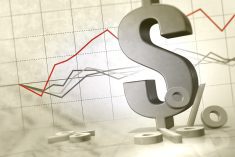There has been a lot of talk lately about inflation and what higher interest rates could mean for the markets, the economy and your investments.
Are rising interest rates bad for stocks? How high can rates go? How will it affect my bottom line? And not just the investment side of your balance sheet but also the financing side of your income statement.
These are all discussions that have come up recently with clients so we’ll look at this and provide some insights into where we may be headed. This is never an easy task since we do our analysis through the lens of history but have to make decisions in real time.
Read Also

Finally getting paid for sustainable farming?
Alberta project says they might have a line on a workable ecosystem credit model to reward farmers for sustainability, and Manitoba might be next
As a starting point, markets now expect the U.S. Federal Reserve central bank will raise interest rates in 2022. People are worried what rising interest rates will mean for the economy as well as the stock market. But do they need to be? If we use history as a guide, perhaps not.
First of all, the Fed will typically only raise interest rates when the economy is strong, so that’s a positive signal. And even if the Fed raises rates by two per cent or more by the end of 2023 as federal fund short-term interest rate futures are currently pricing in, interest rates will still be quite low.
Second, long-term analysis shows that even during the last eight rate rising cycles since 1970, which have lasted on average about 2-1/2 years, the broad-based U.S. stock market, as measured by the Wilshire 5000 Index, still moved up on average around seven per cent during those tightening phases. Furthermore, even six months to a year after an initial rate increase, U.S. stocks have still moved up around five per cent. Based on past trading patterns, rising interest rates may not be as much of a concern for stocks as you think.
While history shows that rising rates doesn’t necessarily have as much impact on the stock market as you might think, higher rates will have a big impact on financing costs. There is, therefore, another interesting point to be aware of and that is that investors often underestimate how high rates can go.
The CME Group futures exchange recently published some interesting research about investors’ behaviour and interest rate hikes called Fed Rate Hikes: Expectations and Reality. In it, they ask: How accurately have investors been at anticipating past Fed tightening cycles?
Looking back on the past four such cycles, the answer is: not very accurate. In every tightening cycle from 1994 onward, investors substantially underestimated the actual amount of rate hikes at the outset of each of the past four tightening cycles by 75 basis points to 175 basis points, based on short-term Fed Fund interest rate futures.
Currently, the 12 largest global banks are expecting the Fed to raise rates on average 150 basis points in the next year. The CME report concludes by saying: “… are they once again underestimating how far the Fed might eventually go? With inflation over seven per cent and unemployment below four per cent, the possibility that the Fed might tighten further than investors currently anticipate seems very real.”
So, if the central banks in Canada and the U.S. raise rates two, three or even four per cent full percentage points, your current three or four per cent financings could turn into five, six, seven or even eight per cent borrowing costs over the next few years. This could add an extra $20,000, $30,000 or $40,000 in interest costs per year for each million dollars of outstanding loans.
I’ve had quite a few conversations with farmers about interest rate strategies and they are looking at these low rates as an opportunity to lock in their financing rates for five, 10 or 15 years, or more. When borrowing costs are this low, the risk reward ratio is certainly skewed against you.
While it is possible rates could drop half a per cent or one per cent back to the lows if another economic recession or market collapse occurs, the greater risk is that rates go higher.
Bottom line, a body in motion tends to stay in that same motion, according to Newton’s second law of motion, and trends can persist longer than you thought possible. History shows that people underestimate how far a rate rising cycle can go.
Since interest rates have been at very low levels for almost 15 years, it’s not so hard to believe that rates could move anywhere from two to four per cent higher over the next two or three years, or longer.
In over 25 years of trading and investing, I’ve learned to never say never, especially when it comes to the markets.















